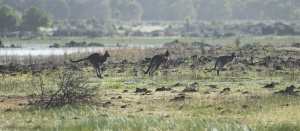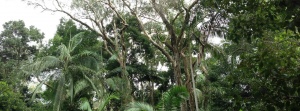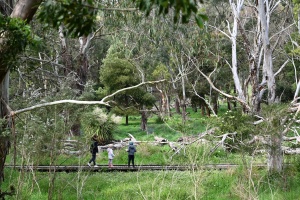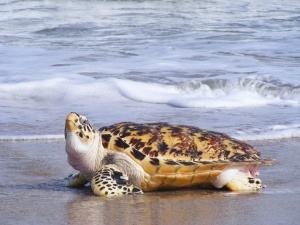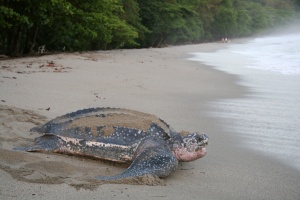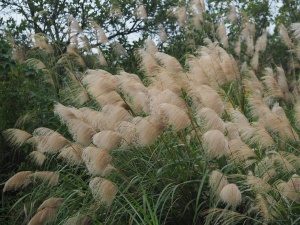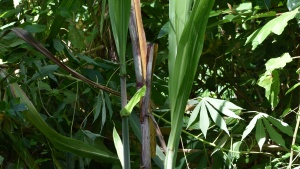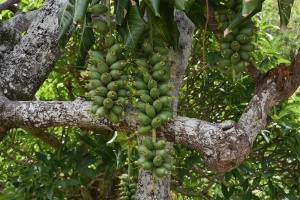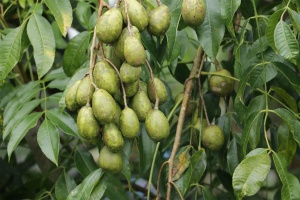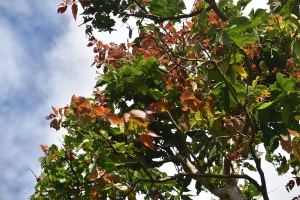Jen Sutfin
Eastern Grey Kangaroo
One of Australia’s most iconic and abundant species, the Eastern Grey Kangaroo is a large marsupial with light grey woolly coloured fur, a darker face, and a long, muscular tail that is dark at the distal third.
Droppings are unevenly round and around 1-3cm in diameter.
Size
The Eastern Grey Kangaroo is sexually dimorphic with males significantly larger than females. Males with body length up to 130cm; tail up to 100cm; weight up to 60kg. Females with body length up to 100cm; tail up to 85cm; weight up to 40kg.
Sunshine Coast – Doonan Creek Environment Reserve, QLD
Explore unique coastal floodplain habitat, remnant wetlands, diverse vegetation, and wildlife on the Doonan Creek ClimateWatch trail.
Valley Lake Conservation Park, Mount Gambier, SA
The Valley Lake Kelta Malpi Conservation Park is located within the Crater Lakes precinct in Mount Gambier featuring picnic facilities, covered shelters, gas barbecues, seating and a playground. The precinct also includes public toilets, extensive parking suitable for buses and access for disabled guests.
Hoksbil Totel (Hawksbill Turtle)
Eretmochelys imbricata
Hoksbil Totel are found in tropical, subtropical and temperate regions of the world, including several nesting areas in Vanuatu. The shell is olive-green or brown with reddish-brown, brown or black markings in a tortoiseshell pattern. The shell is domed and heart-shaped with overlapping scales. The hatchlings are brown to black above and lighter underneath.
Distinctive features
The Hoksbil Totel has a parrot-like beak and narrow head.
Size
Adult females weigh between 60 to 80 kg and have a mean curved carapace (hard upper shell) length of 82 cm, though this can grow up to 100 cm in length.
Behaviour
Movement
Before maturing, they spend the first 5 to 10 years of their life drifting on ocean currents. After this, they settle and forage in tropical tidal and sub-tidal coral and rocky reef habitats.
Diet
Omnivorous but, in many areas, they prefer to eat sea sponges.
Breeding
Night-time nesters. They generally lay 3 to 5 clutches in a season. Each clutch contains around 130 to 160 eggs.
Leta Bak Totel (Leatherback Turtle)
Dermochelys coriacea
Leta Bak Totel are found in tropical and temperate regions of the world, with small numbers nesting in Vanuatu. The shell is made of soft leathery skin with seven ridges or keels. The colour is mostly black with differing amounts of pale spotting, including a pink spot on the heads of adults. It has paddle-like limbs that are clawless and black with white margins and pale spots. Hatchlings are predominantly black with white margins on their flippers and keels on the shell.
Distinctive features
The Leta Bak Totel has a shell that is a soft leathery skin with seven ridges or keels. It is the only sea turtle without a hard shell. It has no teeth and uses its sharp beak to catch food.
Size
The Leta Bak Totel grows up to 180 cm long and weighs up to 700 kg.
Behaviour
Movement
Leta Bak Totels are highly active with individuals spending as little as 0.1% of the day resting. They are one of the deepest-diving marine animals and can move very fast. They are mostly found in open ocean. They follow their preferred prey into deeper water during the daytime and into shallower water at night. Adults can undertake long-distance migration between cold feeding waters and tropical or subtropical beaches where they hatch. Unlike other sea turtles, Leta Bak Totel do not always return to their hatching beach to nest.
Diet
Leta Bak Totel eat mostly jellyfish, but will also take other soft-bodied creatures. Its favourite food is the venomous Portuguese man-o-war jellyfish.
Breeding
They prefer to breed on beaches that face deep water and avoid locations protected by coral reefs. Mating occurs at sea and males never leave the water once they enter as hatchlings. Females mate every 2 to 3 years and can nest up to 10 times in a single nesting season. As many as 9 clutches are laid by a single female in a breeding season, spaced around 9 days apart. Clutch size is around 110 eggs.
Wael Can (Wild Cane)
Miscanthus sp.
Wael Ken grows in clumps and is reed or cane like in form. It reproduces underground through its root system, which sends out shoots that grow upwards. It is used as a traditional building material. The cane can also be used to drink kava once the pith is removed.
Leaves
Leaf sheaths are either free from hair (smooth) or covered in long soft hairs. The leave blades are flat and linear and 18-75 cm long. They have a prominent mid-rib. The leaf margins are sharp with slight serrations.
Flowers
Flower plumes grow from 0.3-2 m or more in height. Flowers are comprised of loose branching cluster with large fan shaped branches 10-40 cm in length. The flowers are purplish. These flower clusters persist through winter.
Naviso
Saccharum edule
Naviso originates from the tropical climates of south-eastern Asia and is grown in various Pacific Islands, including Vanuatu. Naviso is a species of sugarcane. This grass has a fibrous stalk that is rich in sugar. It is perennial, meaning it lives for several years. It grows in vigorous clumps with three to four stalks. The stalks grow to 1.5 to 4 m in height and are often streaked with different colours, depending on the variety.
Leaves
The leaves are pale green and are slightly hairy and rough.
Flowers
The large flower clusters do not open. Instead, they remain enclosed in their leaf sheaths, creating a dense mass that is similar in size to a banana.
Fruits/seeds
This species does not produce seeds. It reproduces using suckers that generate into new plants.
Naval (Cutnut)
Barringtonia edulis
The Naval is endemic to the Solomon Islands, Vanuatu and Papua New Guinea. It is a medium sized tree with a vigorous framework of branches. It typically grows to 8 to 10 m but can grow up to 24 m in height. Most trees have a clear trunk up to one fifth of the tree height which is greyish-brown in colour. It has an extensive framework of branches that have regular fork following the formation of terminal flower clusters. The ‘flowers’ are part of a long hanging spike with over 100 densely packed flower buds, arranged in a spiral pattern. Almost every part of the plant has a traditional use.
Leaves
Leaves are large, simple, lanceolate (pointed at both ends) and are arranged clusters at the ends of the branches. The leaf size varies but is typically 21 to 66 cm long and 5 to 25 cm wide. The upper surface is a glossy dark green and the lower surface is slightly paler. The margins are undulated. Leaf veins are prominent and have a pattern of interlacing lines forming a net or web.
Flowers
A 30 to 110 cm long dangling spike contains up to 150 densely packed flower buds, arranged in spirally alternate pattern. The flowers varying in colour from green to white or red.
Fruit
The fruits are berry-like with short dense hairs. They are elongated, oblong to egg-shaped that taper towards the apex and base. They start as greyish-green and become reddish or purplish as they ripen. The typical length of a mature fruit is 25 – 99 mm. Fruits in Vanuatu are longer and more cylindrical than those in the Solomon Islands.
Naus (Polynesian vi-apple)
Spondias dulcis
Naus is native to the Indo-Malayan region to Tahiti, including Vanuatu. It is a medium sized tree, 10 to 15 m in height, with a straight smooth grey trunk and four to eight small buttresses. The crown of the tree is rounded. In Vanuatu, there is greater variability between forms of this species than anywhere else, and villagers distinguish between different types of this species according to the size, colour and taste of its fruits. Naus loses its leaves during the dry season.
Leaves
The elliptical shaped leaves are 4 to 14 cm in length and 2.5 to 5 cm in width and finely toothed towards the apex. They are a glossy dark green in colour, becoming yellow before falling.
Flowers
The flowers are grouped in loose clusters and are 50 cm long with very small white petals. They are fairly inconspicuous.
Fruit
The fruit is green, yellow, or orange when ripe. It is spherical or egg shaped with a length of 6 to 12 cm and a width of 4.5 to 9 cm. The fruit are found in bunches of 12 or more on a long stalk. The pulp is juicy and yellow or orange, often with fibres that are sometimes arranged in a loose and indistinct matrix. The fruit falls to the ground when green and hard before ripening. Villagers distinguish between several sorts of this species according to the colour and size of the fruit and its taste.
Nandao Tri (Pacific Lychee)
Pometia pinnata
Native to Vanuatu, the Nandao grows in secondary forest up to 300 m in altitude. There are several varieties, ranging from a small to very large tree, but typically is 12 to 20 m tall with a canopy diameter of 10 to 20 m. They are stout trees with short twisted or fluted trunks to slender, fairly straight, trees. Older trees have prominent buttresses. Parts of the tree are used as traditional medicines.
Leaves
Leaflets are firmly herbaceous (herb-like) to coriaceous (leathery), asymmetrical to symmetrical, variably shaped from oblong, lanceolate (pointed at both ends) to egg-shaped. The largest leaves average 12 to 30 cm long and 4 to 10 cm wide. The midrib of the leaf is flat above with a narrow keel that is triangular in section. Leaflet margin is about 3 mm deep, dentate (has a serrated edge) or repand (slightly undulating margin) to subentire (only a few indentations). Juvenile leaves are densely covered in brownish hairs and are large, thin, and initially brightly coloured (pink to red) turning green at maturity.
Flowers
Nandao have highly variable flower clusters, including clusters of terminal, sub-terminal, or rarely axillary loose clusters, conspicuously projecting beyond the foliage, from stiff to hanging long main branches, simple or with secondary branching. Male flowers open first and greatly outnumber female flowers. Flowers are small, have a radial symmetry and are five-parted. The calyx (the part that encloses the petals and protects the buds) is dish shaped to shallow cup-shaped. The flowers have no scent. The flower petals are small and regular and are whitish to yellow-green and highly variable in shape.
Fruit
The fruit is highly variable in shape, from round to elliptical and sometimes paired. The skin of the fruit is smooth and variously coloured (greenish-yellow, yellow, red, purple, blackish or brown) with a gelatinous, sweet, white to slightly pinkish, translucent pulp that partially encases a single large seed. Numerous traditional varieties are recognised locally mainly on the basis of fruit characteristics (size, shape, colour and taste). Two main forms are found in Vanuatu, one with red fruits and the other with green fruits.

